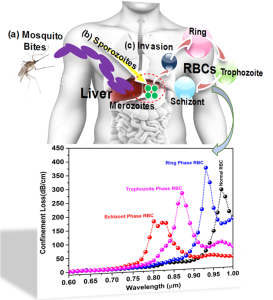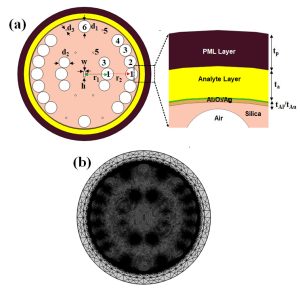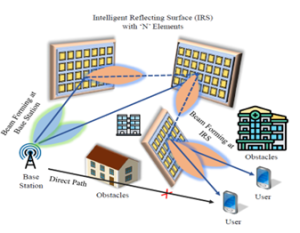All Management News
- Dr Chinmoy Das’s Groundbreaking Research Unveils Promising Discoveries June 26, 2024
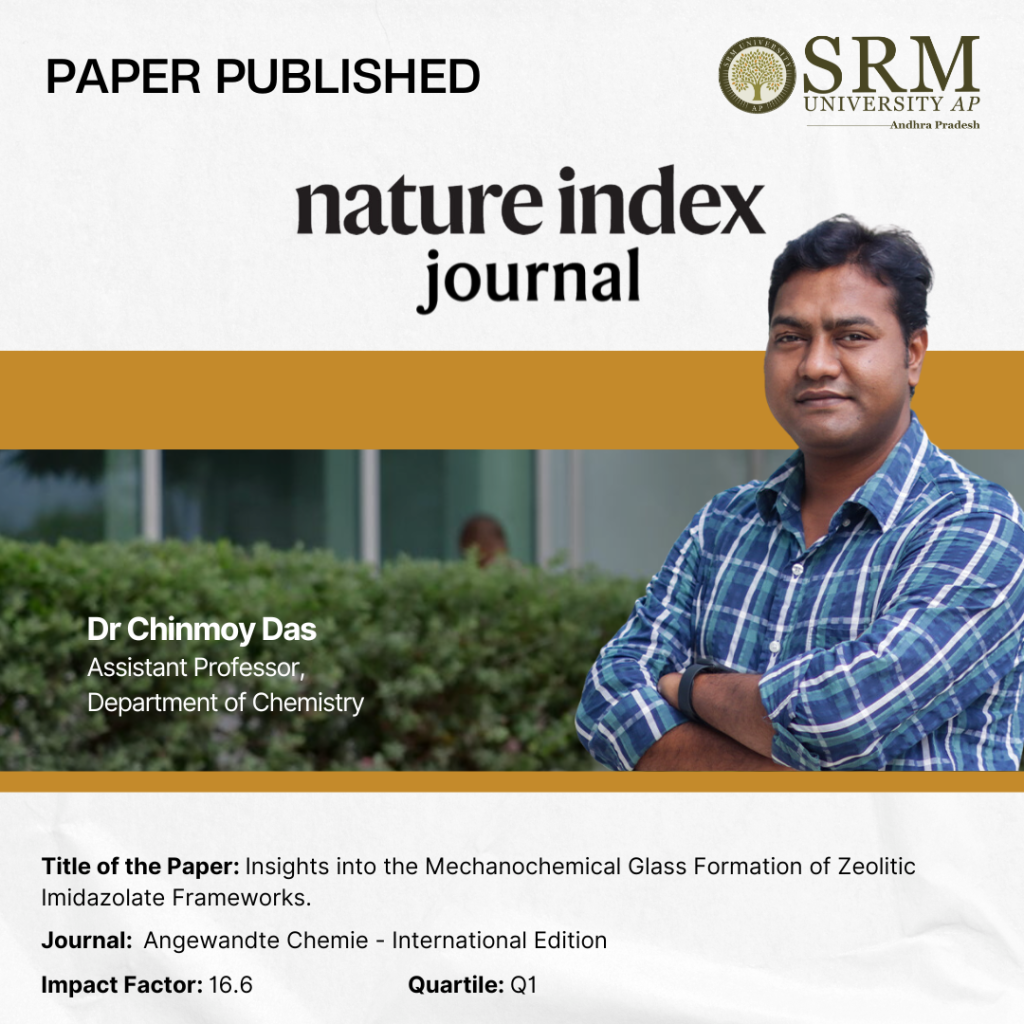
Dr Chinmoy Das, Assistant Professor at the Department of Chemistry at SRM University-AP, has made an impactful contribution with the publication of his research paper, “Insights into the Mechanochemical Glass Formation of Zeolitic Imidazolate Frameworks” in the prestigious Angewandte Chemie International Edition with an impact factor of 16.6. His paper unveils a rapid, eco-friendly, and efficient mechanochemical approach to transform glasses from their crystalline zeolitic imidazolate frameworks. This pioneering work opens new doors for sustainable and effective glass formation, showcasing the power of innovation in the field of chemistry.
Abstract:
We describe a rapid, ecofriendly, and efficient mechanochemical approach to transform glasses from their crystalline zeolitic imidazolate frameworks (ZIFs). We exposition mechanochemical technique through which the traditional melt-quench preparation of glassy phases can be replaced. In this study, we explore that Zn(II), Co(II), and Cu(II)- based crystalline ZIFs transformed into the glassy phases within five minutes through the mechanical ball milling technique. The appearance of glass transition temperature(T g ) upon mechanical milling of crystalline states demonstrated by different characterization techniques, such as X-ray powder diffraction (XRPD), differential scanning calorimetry (DSC), simultaneous thermogravimetric and differential thermal analyses (TG/DTA), scanning electron microscopy (SEM), X-ray total scattering and its deduced pair distribution functions (PDFs). We characterized the porosity and density of the glassy phases through CO 2 gas sorption techniques which aligned with the observation of thermal, structural, and textural features of the ZIFs after varying ball milling times beyond five minutes.
Practical implementation
We can prepare bulk ZIF glasses within five minutes of the mechanochemical approach that will guide the greater feasibility to produce the glass materials for industrial implications. In addition, the greater the accessibility of glassy materials, the greater the fabrication of glassy materials-based device fabrication.
Collaborations
This article has been published with the collaboration of Prof. Sebastian Henke (Henke Group), Department of Chemistry and Chemical Biology, TU Dortmund University, Dortmund, Germany.
Future Research Plans
Recently, we established our research group in SRM University-AP, and our group has started to explore an emergent research area of crystal-glass composite materials towards the applications of atmospheric water harvesting, solid-state electrolytes (Alkali and Alkaline metal ions-based), photovoltaics, and conversion of gaseous Carbon-dioxide molecules to industrially relevant liquids, such as methanol or ethanol.
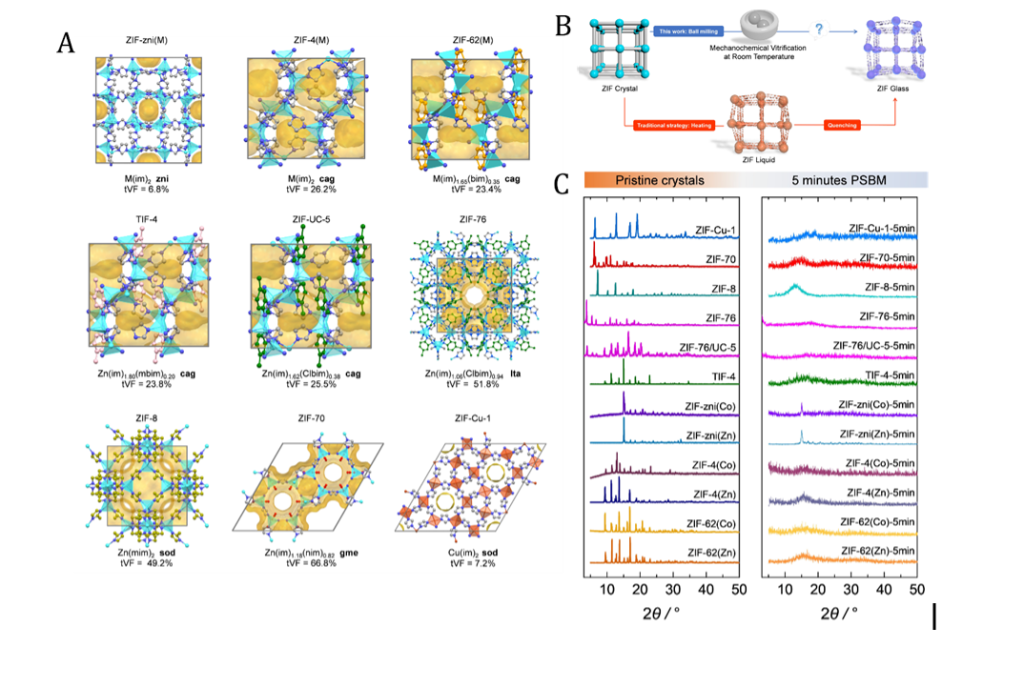
- Figure 1. (A) Single crystal structures of various ZIFs indicated in the figure. (B) Schematic representation of the traditional route to ZIF glass formation (red line) and the mechanochemical vitrification approach followed in this work (blue line). (C) PXRD patterns of the pristine ZIF polycrystalline materials and after five minutes of mechanical ball milling.
Continue reading → - Developing Biosensors using Photonic Crystal Fibres and Surface Plasmon Resonance (SPR) June 25, 2024
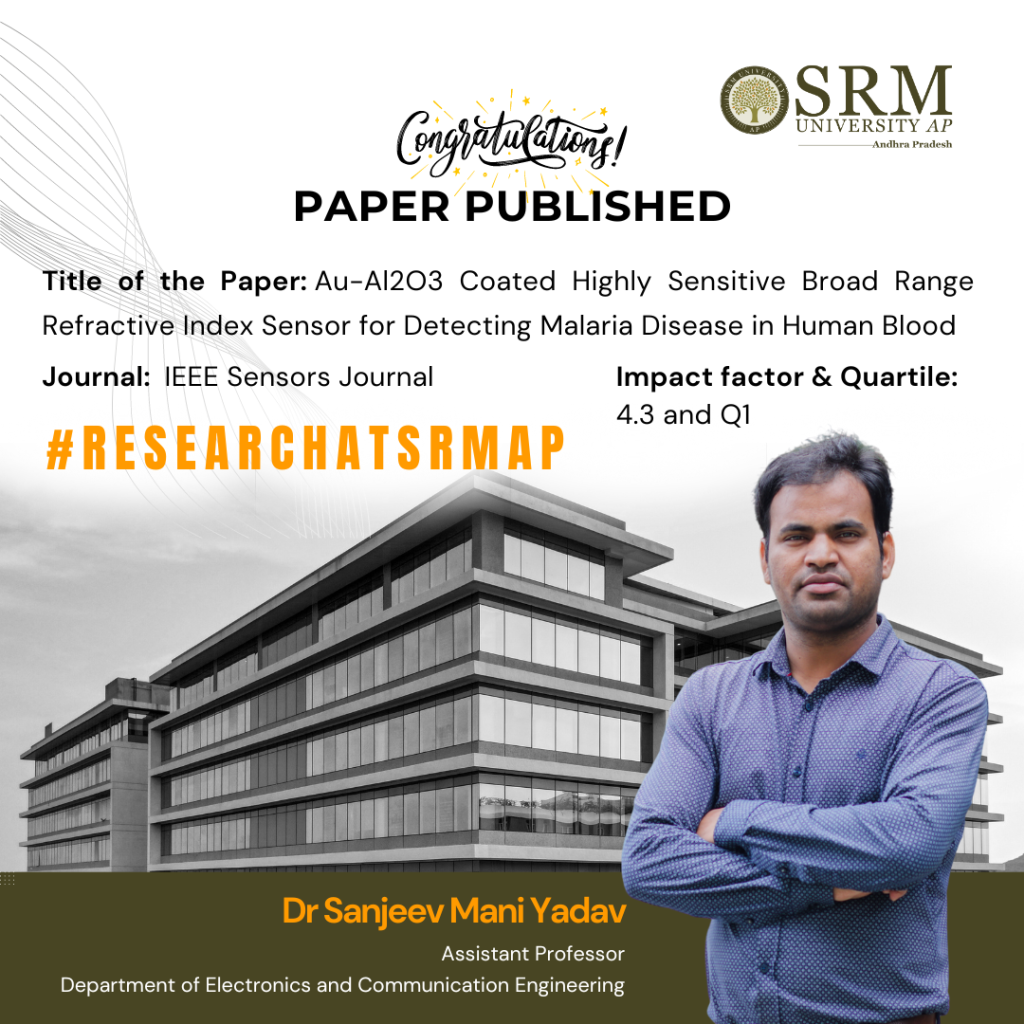
Dr Sanjeev Mani Yadav, Assistant Professor from the Department of Electronics and Communication Engineering, has published a cutting-edge research paper titled “Au-Al2O3 Coated Highly Sensitive Broad Range Refractive Index Sensor for Detecting Malaria Disease in Human Blood” in the IEEE Sensors Journal with an impact factor of 4.3. This research focuses on developing a highly sensitive biosensor using photonic crystal fibres and a technique called surface plasmon resonance (SPR) to detect changes in the refractive index, which is how much light bends when it enters a material. This biosensor can also detect malaria in the human body.
Abstract
The paper represents the photonic crystal fibre-based surface plasmon resonance (SPR) biosensor for broad-range refractive index sensors along with the detection of malaria disease in the human body. α-Al2O3-Au dielectric-metal interface has been proposed to stimulate the free electron on the metal surface via evanescent to result in an SPR phenomenon. The proposed sensor shows a sufficient shift in resonance wavelength for the change in external RI from 1.32 to 1.40 for an optimised Al2O3/Au thickness of 50nm/12nm. The broad-range sensing applicability of the designed sensor shows a maximum sensitivity of 6000 nm/RIU when the external RI changes from 1.38 to 1.40. The detection accuracy of the designed sensor is reported to be 1.66×10-5 (RIU) and reported compatible in comparison to broad RI sensors. The proposed SPR sensor has been utilised to sense the malaria diseases in the human body by filling infected RBC samples on the dielectric-metal surface. The proposed study aids in detecting various stages of malaria-infected RBCs, including the Ring phase, Trophozoite phase, and Schizont phase, by measuring the shift in resonance wavelength. The sensor’s wavelength sensitivity varies across the phases: 5714.28 nm/RIU for the Ring phase, 5263.15 nm/RIU for the Trophozoite phase, and 5931 nm/RIU for the Schizont phase. The sensor exhibits the highest reported sensitivity among other biological sensors in this category. The proposed sensor fulfils all the requirements for a diagnosis of early malaria disease in the human body, along with its high sensitivity, low detection limit, and capability of sensing broad RI.
How does the sensor work?
1. Biosensor Basics: The sensor uses a combination of a special crystal fibre and a metal surface (a mix of aluminium oxide and gold) to create a reaction when light hits it. This reaction is called SPR and it helps in detecting tiny changes.
2. Detecting Changes: When the external refractive index (a measure of how light bends in a substance) changes, the sensor detects this by a shift in the wavelength (colour) of the light. The study found that the sensor is very sensitive to changes in the refractive index between 1.32 and 1.40.
3. Sensitivity: The sensor is incredibly sensitive, with a maximum sensitivity of 6000 nm/RIU (nanometres per refractive index unit). This means it can detect very small changes very accurately.
4. Malaria Detection: The sensor can also detect malaria by analysing infected red blood cells. Different stages of malaria infection (Ring, Trophozoite, and Schizont) cause different shifts in the wavelength, which the sensor can measure. The sensor’s sensitivity varies slightly with each stage but is consistently high.
5. High Performance: This sensor is reported to have the highest sensitivity compared to other similar sensors and meets all the requirements for early malaria diagnosis due to its high sensitivity, low detection limit, and ability to detect a wide range of refractive indices.
In essence, this sensor is a powerful tool for detecting both refractive index changes and malaria in the human body with high accuracy and sensitivity.
Practical implementation/Social implications of the research
The photonic crystal fibre-based SPR biosensor represents a significant advancement in medical diagnostics with wide-ranging practical applications and social implications. Its high sensitivity and accuracy in detecting malaria and potentially other diseases can lead to better health outcomes, economic benefits, and improved access to healthcare, particularly in regions that need it the most.
Dr Sanjeev Mani Yadav acknowledges Dr Amritanshu Pandey, Electronics Engineering Department, IIT (BHU) Varanasi, for his continuous support and guidance throughout this research.
Continue reading → - Unveiling the Dynamics of Labour Market Outcomes June 25, 2024
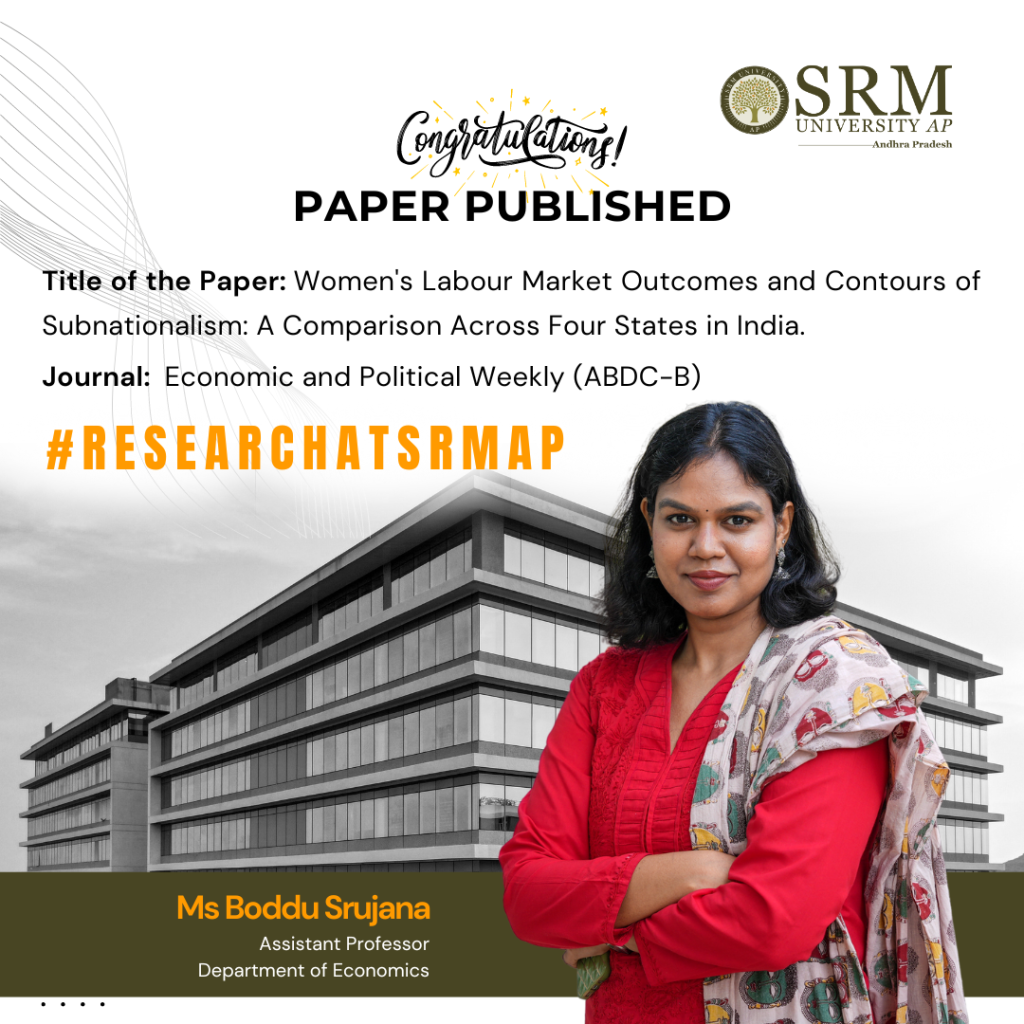
In the wake of the COVID-19 pandemic, societies across the globe were pushed into acute constraints, especially in the absence of employment security and consistency. In this regard, Dr Boddu Srujana, Assistant Professor at the Department of Economics through her research paper titled, Women’s Labour Market Outcomes and Contours of Subnationalism: A Comparison Across Four States in India, scrutinises the impact of the pandemic on women’s employment and thereby explores whether these outcomes were uniformly impacted or if they reveal variations attributable to the political dynamics within these states.
Read the exciting excerpt followed by the link to the article, featured in Economic and Political Weekly
Abstract:
Using, the Periodic Labour Force Survey data for 2018–19 and 2020–21, the article explores shifts in women’s employment outcomes pre- and post-pandemic across four Indian states. The article finds that the states with stronger subnational politics fare better in creating quality employment outcomes for women compared to their counterparts, even during times of crisis such as the recent COVID pandemic. This stands true even for women with disadvantaged social, economic and educational backgrounds.
Practical implementation of research and social implications:
The research highlights the effectiveness of governance and emphasizes social policies over time that can create better job opportunities for women, where they can secure against vulnerabilities even during challenging times such as crises. This leads to greater economic independence, reduces poverty, and promotes social equity.
Collaborators:
The research paper is co-authored with Anagha Tobi and Sipoy Sarveswar.
Anagha Tobi is an Assistant Professor at the Department of Humanities and Social Sciences, Mahindra University, Hyderabad. Sipoy Sarveswar is an Assistant Professor at the Department of Anthropology, Vidya Bhavana, Visva-Bharati, Santiniketan.
Future Plans:
As part of her future research projects in this area, Dr Srujana plans on studying the urban informal labour markets, urbanisation, the dynamics of informalisation, the future of work, and the impact of public policy on labour markets. She is eager to extend her work in these areas by engaging in collaborative research while also partnering with academic institutions, policymakers and NGOs, whereby she aims to contribute to the changing world of work and develop actionable insights that can inform policy and practice
Link to the article.
Continue reading →
https://www.epw.in/journal/2024/23/perspectives/womens-labour-market-outcomes-and-contours.html - A System for Visually Impaired Navigation June 25, 2024
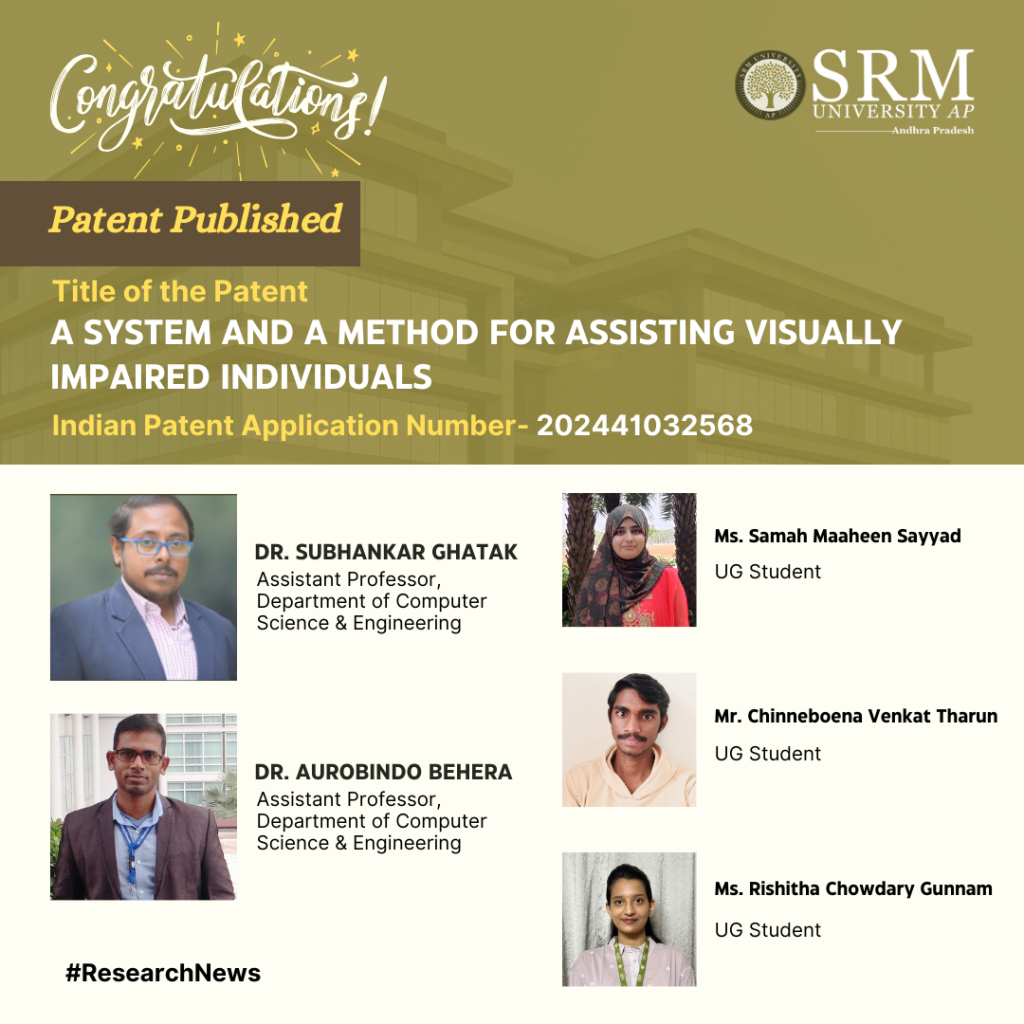
A dedicated team of researchers and professors have developed an innovative patent titled “System and a Method for Assisting Visually Impaired Individuals” that uses cutting-edge technology to significantly improve the navigation experience for visually impaired individuals, fostering greater independence and safety.
The team, comprising Dr Subhankar Ghatak and Dr Aurobindo Behera, Assistant Professors from the Department of Computer Science and Engineering, and students Ms Samah Maaheen Sayyad, Mr Chinneboena Venkat Tharun, and Ms Rishitha Chowdary Gunnam, has designed a system that transforms real-time visual data into vocals via a mobile app. It will utilise wearable cameras, cloud processing, computer vision, and deep learning algorithms. Their solution captures visual information and processes it on the cloud, delivering relevant auditory prompts to users.
Abstract
This patent proposes a novel solution entitled, “System and a method for assisting visually impaired individuals aimed at easing navigation for visually impaired individuals. It integrates cloud technology, computer vision algorithms, and Deep Learning Algorithms to convert real-time visual data into vocal cues delivered through a mobile app. The system
employs wearable cameras to capture visual information, processes it on the cloud, and deliver relevant auditory prompts to aid navigation, enhancing spatial awareness and safety for visually impaired users.Practical implementation/Social implications of the research
The practical implementation of our research involves several key components. Firstly, we need to develop or optimise wearable camera devices that are comfortable and subtle for visually impaired individuals to wear. These cameras should be capable of capturing high-quality real-time visual data. Secondly, we require a robust cloud infrastructure capable of processing this data quickly and efficiently using advanced computer vision algorithms and Deep Learning Algorithms. Lastly, we need to design and develop a user-friendly mobile application that delivers the processed visual information as vocal cues in real-time. This application should be intuitive, customisable, and accessible to visually impaired users.
The social implications of implementing this research are significant. By providing visually impaired individuals with a reliable and efficient navigation aid, we can greatly enhance their independence and quality of life. Navigating city environments can be challenging and hazardous for the visually impaired, leading to increased dependency and reduced mobility. Our solution aims to mitigate these challenges by empowering users to navigate confidently and autonomously. This fosters a more inclusive society where individuals with visual impairments can participate actively in urban mobility, employment, and social activities.
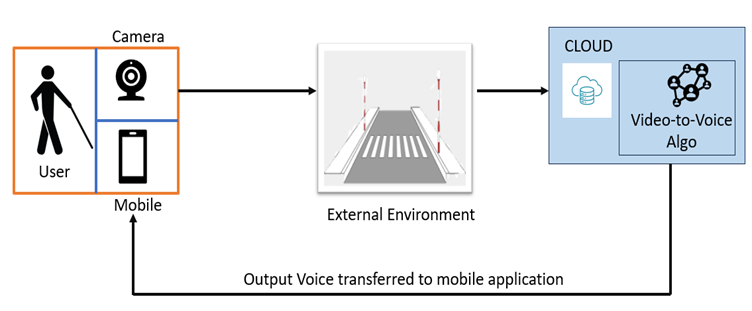
In the future, we plan to further enhance and refine our technology to better serve the needs of visually impaired individuals. This includes improving the accuracy and reliability of object recognition and scene understanding algorithms to provide more detailed and contextually relevant vocal cues. Additionally, we aim to explore novel sensor technologies and integration methods to expand the capabilities of our system, such as incorporating haptic feedback for enhanced spatial awareness.
Furthermore, we intend to conduct extensive user testing and feedback sessions to iteratively improve the usability and effectiveness of our solution. This user-centric approach will ensure that our technology meets the diverse needs and preferences of visually impaired users in various real-world scenarios.
Moreover, we are committed to collaborating with stakeholders, including advocacy groups, healthcare professionals, and technology companies, to promote the adoption and dissemination of our technology on a larger scale. By fostering partnerships and engaging with the community, we can maximize the positive impact of our research on the lives of visually impaired individuals worldwide.
Continue reading → - Teacher-Student Duo Collaborate to Achieve Scientific Excellence June 25, 2024
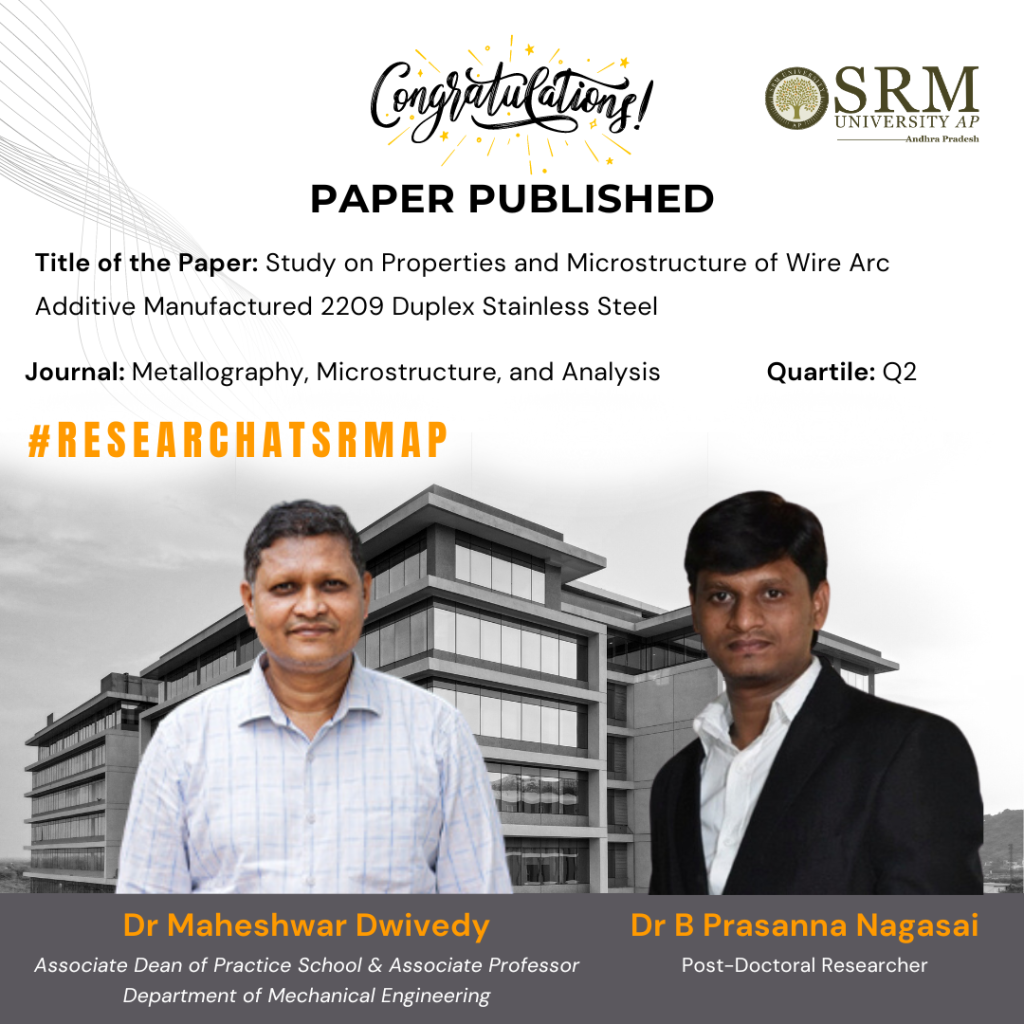
The Department of Mechanical Engineering at SRM University-AP is proud to present its research paper titled, Study on Properties and Microstructure of Wire Arc Additive Manufactured 2209 Duplex Stainless Steel by Dr Maheshwar Dwivedy and post-doctoral researcher, Dr B Prasanna Nagasai. Below is a brief write-up on their research.
Abstract:
This study investigates the properties and microstructure of 2209 duplex stainless steel (DSS) components fabricated using the wire arc additive manufacturing (WAAM) technique, specifically employing the gas metal arc welding (GMAW) process. The research focuses on the mechanical properties and microstructural characteristics of the produced cylindrical components. Detailed examination revealed that the microstructure varied from the bottom (region ①) to the top (region ②) of the cylinders, with hardness measurements ranging from 301 HV0.5 to 327 HV0.5, and impact toughness values from 118J to 154J. The tensile properties exhibited anisotropic behavior, with ultimate tensile strength and yield strength ranging from 750 to 790 MPa and 566 to 594 MPa, respectively. The study highlights the significant influence of complex heat cycles and cooling rates on the primary phase balance, resulting in a 50/50 austenite/ferrite distribution. Additionally, σ-phase precipitation was observed at the ferrite grain boundaries. The observed increase in austenite content from region ① to region ② is attributed to reduced cooling rates and extended time for solid-state phase transformation. This research provides valuable insights into optimizing the WAAM process for enhanced performance of 2209 DSS components.
Citation Format:
Prasanna Nagasai, B, Maheshwar Dwivedy, Malarvizhi, S. et al. Study on Properties and Microstructure of Wire Arc Additive Manufactured 2209 Duplex Stainless Steel. Metallogr. Microstruct. Anal. (2024). https://doi.org/10.1007/s13632-024-01089-8
Practical implementation:
The practical implementation of this research on Wire Arc Additive Manufacturing (WAAM) for Duplex Stainless Steel (DSS) has significant implications for industries requiring high-strength, corrosion-resistant components, such as construction, marine, and chemical processing. By optimizing the WAAM process to produce DSS parts with balanced microstructures, manufacturers can create durable and efficient parts more cost-effectively and with less material waste than traditional methods. This advancement could lead to more sustainable manufacturing practices, reducing the environmental impact and operational costs associated with producing large metal components. Socially, the widespread adoption of this technology could drive innovation, create new job opportunities in advanced manufacturing, and contribute to the development of stronger, longer-lasting infrastructure and machinery, ultimately benefiting the economy and society at large.
Collaborations:
Dr V Balasubramanian,
Professor & Director,
Centre for Materials Joining & Research (CEMAJOR)
Annamalai University, Annamalai Nagar-608002, Tamilnadu.Dr P Snehalatha,
Associate Professor & Head
Department of Mechanical Engineering,
Sri Padmavathi Mahila Visvavidyalam, Tirupati, Andhra Pradesh-517502, India.Future Research Plans:
In our upcoming work, we will focus on developing Functionally Graded Materials (FGMs) using Wire Arc Additive Manufacturing (WAAM), combining nickel and stainless steel. This research aims to harness the unique properties of each metal to create components tailored for specialized applications requiring high performance. Key challenges include optimizing material interfaces, refining deposition processes, and ensuring robust structural integrity throughout production.
The link to the article– https://doi.org/10.1007/s13632-024-01089-8
Continue reading → - Cutting-Edge Research by Dr Chinnadurai Elevates MIMO Wireless Communication Standards June 25, 2024
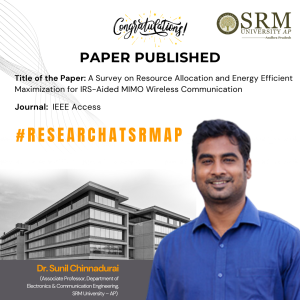
A Survey on Resource Allocation and Energy Efficient Maximization for IRS-Aided MIMO Wireless Communication
In a significant advancement for wireless communication technology, Dr Sunil Chinnadurai, Associate Professor in the Department of Electronics & Communication Engineering, has made a remarkable contribution to the field. His latest paper, titled “A Survey on Resource Allocation and Energy Efficient Maximization for IRS-Aided MIMO Wireless Communication,” has been published in the prestigious journal IEEE Access.
The paper delves into the intricacies of Intelligent Reflecting Surfaces (IRS) and their role in enhancing Multiple Input Multiple Output (MIMO) wireless communication systems. Dr. Chinnadurai’s research focuses on optimizing resource allocation and maximizing energy efficiency, which is a critical aspect of sustainable technological development.
This publication is expected to pave the way for more efficient and environmentally friendly wireless communication solutions, reflecting Dr Chinnadurai’s commitment to innovation and excellence in research.Abstract of the Research
This paper surveys the integration of Multiple-Input Multiple-Output (MIMO) systems with Intelligent Reflecting Surfaces (IRS) in wireless communications. It explores how IRS technology enhances MIMO performance by manipulating the propagation environment through improved signal manipulation and beamforming. The survey covers resource allocation, energy efficiency techniques, optimization strategies, and practical implementation challenges. Key research areas and future directions are highlighted, emphasizing the potential of MIMO-enabled IRS systems to enhance wireless communication efficiency and coverage significantly.
Explanation of the Research in Layperson’s Terms
This paper explores how two advanced technologies, MIMO and IRS, can improve wireless communications. MIMO uses multiple antennas to enhance data transmission, while IRS involves smart surfaces that direct signal paths to boost strength and coverage. By combining these technologies, the paper examines how to make wireless networks faster, more reliable, and energy-efficient. It discusses practical ways to implement these improvements and identifies challenges and future research areas to make these advancements widely usable. In essence, this combination promises better wireless connectivity for everyone.
Practical Implementation or the Social Implications Associated with the Research
Integrating MIMO and IRS technologies into wireless networks can significantly enhance network performance, especially in urban and rural areas. Telecommunications companies can install IRS panels on structures to boost signal strength and coverage, while smart homes and cities can benefit from improved IoT connectivity and energy management. This combination also promotes energy-efficient networks, reducing operational costs and environmental impact. Socially, this technology can bridge the digital divide, providing better internet access to underserved areas and enhancing education, healthcare, and economic development. It supports new business models and innovations, leading to job creation and economic growth. Improved connectivity enhances quality of life through better access to information, entertainment, and remote work opportunities. Additionally, it strengthens public safety by improving communication during emergencies. Combining MIMO and IRS technologies promises a more connected, efficient, and sustainable world.
Pictures Related to the Research:
Future Research Plans
Future research on MIMO and IRS integration should focus on advanced optimisation for resource allocation and energy efficiency, innovative beamforming strategies, practical deployment challenges, and robust security protocols. Enhancing energy efficiency and contributing to standardization and regulation is also critical. These efforts will unlock the full potential of MIMO and IRS, leading to more efficient, reliable, and secure wireless communication systems.
Continue reading → - From Views to Votes: Faculty Duo Unveils Political Activism on YouTube June 25, 2024
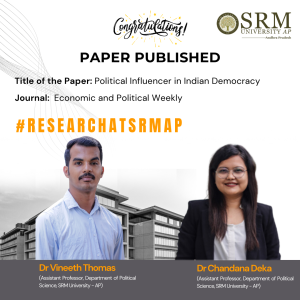 In a significant contribution to the field of politics, Dr Vineeth Thomas and Dr Chandana Deka, Assistant Professors in the Department of Political Science, have published an insightful paper titled “Political Influencer in Indian Democracy” in the esteemed Journal Economic and Political Weekly. Their work delves into the burgeoning role of YouTube as a platform for political engagement, highlighting a shift in the digital landscape where entertainment and politics intersect.
In a significant contribution to the field of politics, Dr Vineeth Thomas and Dr Chandana Deka, Assistant Professors in the Department of Political Science, have published an insightful paper titled “Political Influencer in Indian Democracy” in the esteemed Journal Economic and Political Weekly. Their work delves into the burgeoning role of YouTube as a platform for political engagement, highlighting a shift in the digital landscape where entertainment and politics intersect.The paper explores the emergence of a new breed of political influencers who are leveraging the power of social media activism to shape public discourse. This pioneering study offers a fresh perspective on the dynamics of political communication in the age of digital media.
Abstract
In the YouTube landscape dominated by entertainment, Dhruv Rathee emerges as a prominent voice in political discourse and social media activism. His casual demeanour belies his impactful mission to mobilise Indians against perceived authoritarianism under the Modi government. Rathee’s journey began in 2016, focusing initially on educational content before delving into political commentary. His videos, known for their thorough research and straightforward presentation, address issues like governance, free speech, and electoral fraud. Despite criticisms of superficiality in his economic analyses, Rathee’s engaging style and significant social media influence highlight the transformative power of digital platforms in shaping public discourse. While YouTube journalism thrives on engagement and immediacy, traditional media’s depth and editorial rigor ensure its continued relevance in the media ecosystem.
Explanation of the Research in Layperson’s terms
Dhruv Rathee, a prominent YouTuber, has made a significant impact in the realm of political discourse and social media activism in India. Starting his journey around 2016, Rathee transitioned from creating educational content to addressing political issues, driven by his dissatisfaction with Prime Minister Narendra Modi’s administration. His videos are characterized by meticulous research and straightforward presentation, covering a wide range of topics such as governance, free speech, electoral fraud, and media bias. Rathee’s engaging style, which blends factual rigor with a conversational tone, has enabled him to connect with a broad audience, making complex political issues accessible to the layperson.
Despite criticisms of his sometimes superficial understanding of economic issues, Rathee’s ability to mobilise large audiences and his significant social media presence underscore the transformative potential of digital platforms in shaping public discourse. However, YouTube journalism, which often centers around individual personalities, can lack the depth and breadth of traditional journalism, emphasizing engagement and immediacy over comprehensive coverage.
In Traditional media, with its extensive resources, editorial rigor, and established trust, continues to play a vital role in the media landscape. Although mainstream media has faced criticism for spreading misinformation and manipulating public discourse, its structured approach to news remains indispensable. Both YouTube and traditional media have their strengths and limitations, highlighting the need for a balanced approach to news consumption from multiple sources to ensure a well-rounded understanding of current events.
Practical Implementation or the Social Implications Associated
The practical implementation of this research emphasises the necessity for a balanced approach to news consumption, combining insights from both YouTube influencers and traditional media to foster informed public discourse and preserve democratic values.
Collaborations
Electoral Politics
Future Research Plans
Indian govt and politics
Continue reading → - Dr G Santhosh Kumar June 25, 2024
- Dr Isunuri Bala Venkateswarlu June 21, 2024
- Dr Jogendra Singh Rana June 21, 2024


